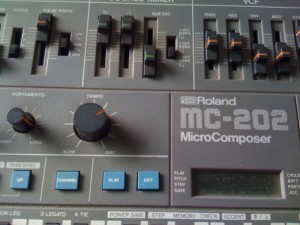
another find from the internet archive
The 202
is one of my favourite instruments too.. bang for buck and size…
if only someone could figure a way to hack it to be more of a
multi-pattern based sequencer… Anyways, here’s a contribution….Some people go nuts for the 303’s slide, I’ve heared that its a fixed
time slide… but the thing imho that makes it sound kewl is the fact
that it starts sliding from one note to the next when its finnishing
the first note, rather than when it starts the next… to do this on
the synth we all know and love, the mc202, program in some little
‘slide premonition’ notes like this:pitch C2 C2 B2 C3
step 24 11 01p 12p
gate 12 11 01 6a really unimaginitive sequence but notice that the second note is
only 11 units long both in gate and step, it then slides up to b2
before sliding to c3, but does so at the end of the 12 units of a
16th note… the second and third notes could have step and gate
times of different values to taste and for desired tempo. Add some
accents in FA mode and you’re further into the confined space of the
303’s brain…If you have a 303 as well, hook ’em up…
sync out of 202 into 303
cv/gate out of 303 into EXT KYBD in on 202
set tempo on 202 to slow…
put 202 in Real time record mode and hit start…
The 202 will actually quantise the nice 303 slides into these ‘slide
premonition’ type notes anyway… though it’s smoother if you edit
the gate times of these little notes to be the same as their step
times and put portamento on them and the notes they’re sliding to..
and once again accent has to be entered manually…these techniques lend to an acid that has some of the 303’s
characteristics but one that has its own bent on the actual sound –
as long as the programming is more interesting than my example;)fairly obvious I guess…
Also, when using the squarewave (NOT the sub osc) never have it on 100% pulsewidth square. You want to notch it up to the 3rd line – THEN you get that TB303 “square”
thanks for the tip.
I’ve got the proper cv/gate mod for my 202 now and using the sq1 with it.
Getting some nice acid vibes.